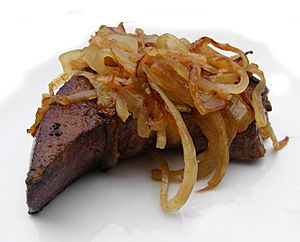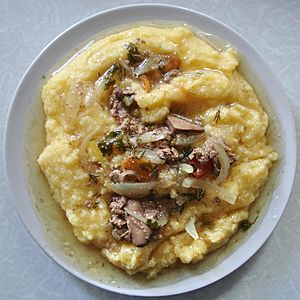Liver (food) facts for kids
The liver from animals like mammals, birds, and fish is often eaten by people. You can find livers from pigs, lambs, calves, chickens, geese, and cod in most butcher shops and supermarkets. In some parts of Europe, people also eat livers from stingrays and burbot fish.

| Nutritional value per 100 g (3.5 oz) | |
|---|---|
| Energy | 561 kJ (134 kcal) |
|
2.5 g
|
|
|
3.7 g
|
|
|
Protein
|
21 g
|
| Vitamins | Quantity
%DV†
|
| Vitamin A equiv. |
813%
6500 μg |
| Niacin (B3) |
94%
15 mg |
| Vitamin B6 |
54%
0.7 mg |
| Folate (B9) |
53%
212 μg |
| Vitamin B12 |
1083%
26 μg |
| Vitamin C |
28%
23 mg |
| Minerals | Quantity
%DV†
|
| Iron |
177%
23 mg |
| Sodium |
6%
87 mg |
|
Calf liver and chicken liver are comparable.
|
|
| †Percentages estimated using US recommendations for adults. | |

Animal livers are packed with important nutrients like iron, copper, different B vitamins, and vitamin A. While liver is very healthy, eating too much of it every day might not be good because it has a lot of vitamin A. For example, just one serving of beef liver has more vitamin A than the recommended daily limit for adults.
Contents
Cooking and Eating Liver
Liver can be cooked in many ways! You can bake it, boil it, broil it, fry it, or even stir-fry it.
In many dishes, pieces of liver are cooked with other meats or kidneys. For example, in the Middle East, they have dishes like meurav Yerushalmi, which is a mix of different meats and liver.
Liver is also used to make spreads and pâtés. Some popular ones include liver pâté, chopped liver, liverwurst, and Braunschweiger. There are also sausages made with liver, like mazzafegato. In South Africa, there's a special dish called skilpadjies, which is minced lamb's liver wrapped in a fatty membrane and grilled.
Fish Liver as Food
Some types of fish liver are also enjoyed as food. The liver of the stingray is especially popular in some places. In England, people make poached skate liver on toast. In French cuisine, you might find beignets de foie de raie (fried stingray liver) or foie de raie en croute (stingray liver in pastry).
Cod liver, often sold in cans with oil, is a popular spread for bread or toast in many European countries. In Russia, it's often served with potatoes. You might also know about cod liver oil, which is a common dietary supplement because it's full of vitamins.
In Finland, people eat the liver of the burbot fish. Fish sellers often sell burbot with its liver and roe (eggs) still attached. These parts are usually boiled or added to burbot soup, making burbot and its liver a traditional winter meal.
Important Safety Tips for Eating Liver
While liver is very nutritious, it's important to know that extremely high amounts of vitamin A can be harmful. This condition is called hypervitaminosis A.
The livers of some animals, like polar bears, walruses, and bearded seals, contain extremely high levels of vitamin A. Because of this, people like the Inuit (who live in the Arctic) do not eat the liver of polar bears or bearded seals. Eating even a small amount of these livers could be dangerous for humans.
Another example is the pufferfish, which is eaten in Japanese cuisine as fugu. The liver of the pufferfish has the highest concentration of a very strong poison called tetrodotoxin. Because of this, it has been against the law to serve pufferfish liver in Japan since 1984.
Also, in 2012, the government of Nunavut (a territory in Canada) advised pregnant women not to eat ringed seal liver because it can have high levels of mercury.
Traditions with Liver
Pig liver is a traditional food for Okinawan immigrants in Hawaii. It used to be a special dish eaten on New Year's Eve.
See also
 In Spanish: Hígado (gastronomía) para niños
In Spanish: Hígado (gastronomía) para niños


